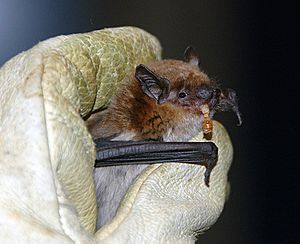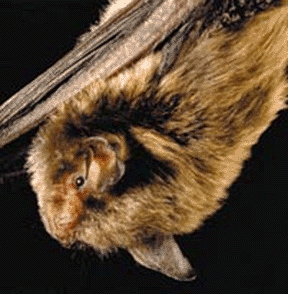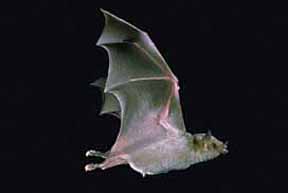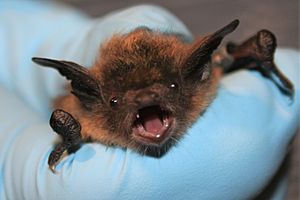List of bats of the United States facts for kids
All bat species in the United States mostly eat insects. However, there are a few exceptions! Three types of bats that migrate from Mexico enjoy nectar, and one kind of fruit-eating bat lives only in the Florida Keys.
Contents
Bat Species in the U.S.
Bats are amazing flying mammals that belong to a special group called Chiroptera. Think of it like how cats belong to the "Felidae" family. In North America, you can find bats from four main families: Vespertilionidae, Molossidae, Mormoopidae, and Phyllostomidae. Each family has its own unique types of bats!
Molossidae: Free-tailed Bats
This family is known for bats with tails that stick out beyond their flight membranes, making them look "free-tailed." They are often fast flyers.
- Florida bonneted bat, Eumops floridanus
- Western mastiff bat, Eumops perotis
- Mexican free-tailed bat, Tadarida brasiliensis
Mormoopidae: Leaf-chinned Bats
Bats in this family often have unique skin folds around their chins or faces.
- Ghost-faced bat, Mormoops megalophylla
Phyllostomidae: New World Leaf-nosed Bats
These bats are very diverse! Some eat fruit, some eat nectar, and some even eat small animals. Many have a special leaf-like shape on their nose.
- Jamaican fruit bat, Artibeus jamaicensis (found only in the Florida Keys)
- Mexican long-nosed bat, Leptonycteris nivalis
- California leaf-nosed bat, Macrotus californicus
Vespertilionidae: Common Bats
This is the largest family of bats, and many of the bats you might know belong here. They are often called "evening bats."
- Pallid bat, Antrozous pallidus
- Rafinesque's big-eared bat, Corynorhinus rafinesquii
- Townsend's big-eared bat, Corynorhinus townsendii
- Big brown bat, Eptesicus fuscus
- Silver-haired bat, Lasionycteris noctivagans
- Eastern red bat, Lasiurus borealis
- Hoary bat, Lasiurus cinereus
- Little brown bat, Myotis lucifugus
- Indiana bat, Myotis sodalis
- Tricolored bat, Perimyotis subflavus
Amazing Bat Roosts
Bats need safe places to rest during the day, raise their young, and hibernate in winter. These places are called "roosts." Some roosts are very famous!
Grandview Mine Bat Research
In 2009, the Grandview Mine in Grand Canyon National Park got special gates. These gates help protect the bats living there. They also help researchers study bats and keep visitors safe.
Austin's Congress Avenue Bridge
The Ann W. Richards Congress Avenue Bridge in Austin, Texas, is home to the world's largest group of bats living in a city! Millions of Mexican free-tailed bats live under this bridge. Every evening, they fly out together to hunt insects. It's an amazing sight to see!
Carlsbad Caverns Bat Colony
Carlsbad Caverns National Park is famous for its caves and its bats. Seventeen different kinds of bats live here. A huge number of Mexican free-tailed bats call these caverns home. In the past, millions of these bats lived here. Their numbers have gone down over time. Scientists believe pesticides might have played a role in this decline.
State Bats of the U.S.
Just like states have official birds or flowers, some states have an official "state bat"! This helps raise awareness about these important creatures.
- In 2015, Hawai'i chose the Hawaiian hoary bat as its official state land mammal.
- In 2020, the big brown bat became the official state mammal for the District of Columbia.
- In 2023, the pallid bat was chosen as the state bat of California.
Here's a quick look at some of the states with official bats:
| State | State bat | Scientific name | Image | Year adopted |
|---|---|---|---|---|
| Oklahoma | Mexican free-tailed bat | Tadarida brasiliensis | 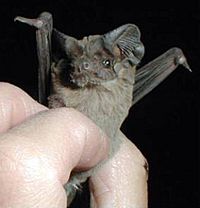 |
2006 |
| Texas | 1995 | |||
| Virginia | Virginia big-eared bat | Corynorhinus townsendii virginianus | 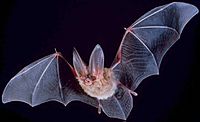 |
2005 |
| California | Pallid bat | Antrozous pallidus |  |
2024 |
See also
- Environment of the United States


